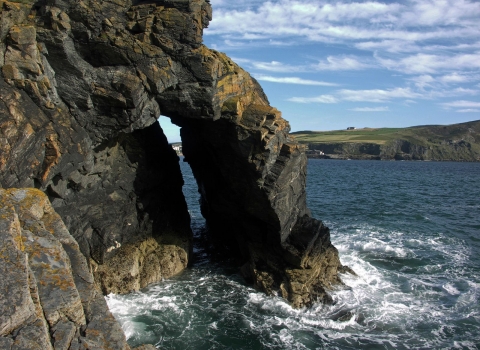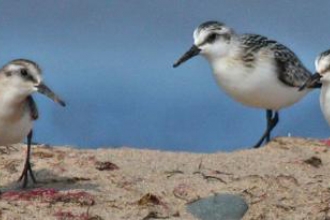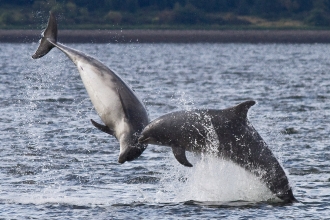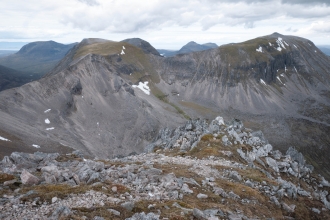Dramatic views and beautiful habitats
The Isle of Man has a great range of wild places, from heather moorland to low-lying willow carr woodland and a dramatic coastal cliff line.
From open heather moorlands which adorn the uplands up to the island's highest point, Snaefell, at 2034 ft, to low-lying willow and alder carr woodland (called Curragh on the island) in the valleys and post-glacial depression of the northern plain, there's such a wide variety of habitats here on the Isle of Man
The Northern Plain
The area from Kirk Michael to Sulby and on to Ramsey is low-lying and generally flat. A post-glacial outwash plain, the area is predominantly made up of arable and livestock farming, but with some interesting and notable habitats: soft low sandstone cliffs, yellow and grey sand dune complexes, drumlin hill formations and lichen heath complex. Ballaugh Curragh and Cranstal basin are sites of dried out post-glacial lakes that hold wet carr semi-fen and bog habitat, secondary woodland and hay meadows.
Northern Uplands
Wide open, heather moorland landscape with conifer plantations and occasional fragments of broadleaf woodland on the flanks and in the valleys. There are pockets of acid grassland, bog and acid flushes in depressions and hollows. The area is dominated by the island's highest point at Snaefell with a ring of steep valleys radiating away from it: the Ballaugh, Sulby, Laxey, East and West Baldwin valleys. Rivers are fast flowing spate rivers often good for salmonids. In a few places these rivers flow out to form remnant saltmarsh habitats, such as those near Ramsey.
The Central Valley
A low-lying river valley, mixed and broadleaf woodland, occasional wet meadow. Fen and hay-meadow features are bordered by livestock farming and occasional gorse scrub areas.
The Southern Uplands
Being lower and smaller than the north, the uplands of the south harbour a smaller area of heather, bracken and gorse colonised moorland, but one that is managed on a smaller, more wildlife friendly scale. A small-scale field pattern of livestock grazed farmland runs up to the edge of the moorland to the west; the hard Manx series slate falls to the sea in a dramatic coastal cliff line with bracken, heather and acid grassland falling to the upper strandlines.
Castletown
Castletown, the ancient capital of Man, is dominated by limestone geology giving rise to a more calcarious grassland, some arable farming, low-lying coastal cliffs with limestone bedding and wide open sand and gravel beaches. A few small scale blocks of reedbed are found in this area.
Peel
Dominated by sandstone geology, with low lying but often sheer coastal cliffs, this area on the west coast of the island has mixed arable and livestock farming, good quality lowland river features along the Neb, and occasional species rich meadows.
South and the Calf of Man
Meayll Peninsular in the far south and the Calf are both heavily slate dominated with dramatic sheer cliff lines falling to deep water on all sides. Western gorse and heather dominate the coastal heathlands, whilst further inland there are pockets of acid grassland and a traditional small scale field pattern with interdividing stone walls.
The Calf of Man
The islet to the south of the Isle of Man, may be small but provides a home for many species of birds and other wildlife. It was farmed for many years before becoming a Bird Observatory in 1959. It is home to around 33 species of breeding birds many of which are seabirds. The Calf is also used as a resting point for many other species on their annual migration. Some of our breeding species include greater and lesser black backed gulls, herring gulls, shag, guillemots, razorbills, chough, peregrine and raven. The Islet is an important nesting site for Manx shearwater who nest in burrows on the cliff edges. Numbers were once vast but sadly have more recently declined, most likely due to the introduction of rats (locally known as 'longtails') after a shipwreck on the cliffs. The Manx Shearwater Project has since been set up to eradicate these rats that feed on the eggs and chicks. The programme started in 2012 and there are already signs that Manx shearwater numbers are increasing. A puffin re-introduction programme has subsequently been set up to encourage puffins to nest again on the Calf as they too are affected by rats eating their eggs and chicks. Other visitors to this beautiful island include seals, basking sharks and cetaceans. Seals use the area during the Autumn to give birth to their pups, drawn in by the undisturbed quiet that is provided by the Calf.
Trips to the Calf can be organised with various boats out of Port St Mary or Port Erin. Overnight stays are possible but must be booked through Manx National Heritage's website.
Coastal viewing sites
There is a network of six viewing sites around the Island’s coastline providing a great opportunity to see and learn more about our coastal and marine life. Go visit them at:
- Marine Drive, Douglas
- Kallow Point, Port St Mary
- Bradda Glen, Port Erin
- Niarbyl, Dalby
- Breakwater, Peel
- Old Grammar School, near Castletown harbour, Castletown







